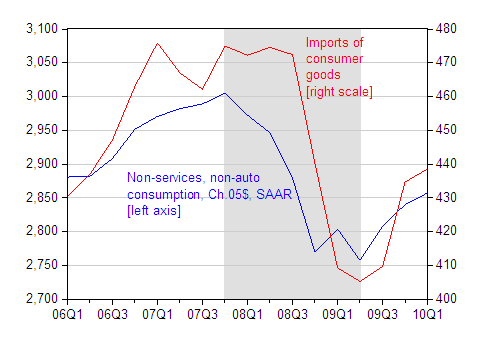The March trade release came in close to consensus (although suggesting higher 2010Q1 growth [0]). Comparing the advance release figures on real goods imports against the Jan-Mar figures from the trade release doesn’t suggest a big revision (about 7.5 billion Ch.05$ on SAAR). I thought it would be interesting to see if there were any indications that American consumers were weaning themselves off of foreign consumer goods, using the 2010Q1 Advance release figures.
One of the main questions surrounding rebalancing the world economy centers on to what extent, and how, consumption resumes in the United States [1] [2] [3]. Figure 1 plots non-services, non-auto consumption (proxied by the total real consumption minus real services consumption and real auto consumption expenditures), and consumer goods imports, over the 2006-2010 period.

Figure 1: Non-services, non-auto consumption (blue, left axis), and consumer goods imports (red, right axis), both in Ch.2005$ SAAR. NBER defined recession dates shaded gray, assumes recession ends 2009Q2. Non-services, non-auto consumption approximated by subtracting services and auto expenditures from total consumption. Source: BEA, 2010Q1 GDP advance release, NBER, and author’s calculations.
The key take-aways: (1) non-services, non-auto consumption is 5.0% lower (in log terms) than it was at its peak in 07Q4; (2) consumer goods plus auto imports are 8.0% lower than its level in 07Q4; (3) while the former has decreased 147.6 billion Ch.05$ SAAR, while the latter has dropped 36.4 billion Ch.05$
Using the correlation between the two that held over the 2006Q1-08Q2 period, there is no evidence that by 2010Q1 a shift had occurred in the share of domestic sourcing of ex-auto goods consumption. This doesn’t mean there wasn’t any shifting – merely that with the data available, no shift could be detected (the auto consumption series measured in 2005$ only extends back to 2006Q1).
More on the trade release from Calculated Risk and Free Exchange.
As CR noted, back to the old (unsustainable) trade imbalances. Apparently, this will not be stopped until it becomes a crisis, as it has in Europe.
OT:
At the EIA Conference last month, we were able to submit questions to Larry Summers, the luncheon speaker. I asked, “At what oil price does US consumption begin to decline?” and “And what oil price will the US economy be materially impeded in re-hiring the unemployed?”
Now Summers is a smart guy, and he knew he should of known the answer, and didn’t. So he ducked the questions: “Prices will vary.” Well, the EIA’s April Short Term Energy Outlook (STEO) gives us some pretty good circumstancial data on the first question. In my recent presentations, I have been arguing that “if oil stays in the $80+ range, job growth in the US will be oil-less.” This appears to be the case.
The STEO lists the average April WTI spot oil price at $84.29. And in April, oil demand declined in the OECD countries across the board: the US, Europe, Japan, Canada, other OECD. (And interestingly, once again, declines were counter-intuitively higher in the high fuel tax countries.)
Oil demand increased in the non-OECD countries virtually across the board: China, other non-OECD Asia, FSU all up smartly. This supports the contention of ML/BoA analyst Francisco Blanch (still one of the best in the business, in my opinion) that the non-OECD can support higher oil prices than the OECD.
It also suggest the non-OECD continuing to bid away the OECD’s oil supply. The oil price is at the fulcrum (just as theory would suggest), the price at which the OECD will cede consumption to the non-OECD. And the data suggests that’s exactly what’s happening.
So, at what price will OECD consumption decline? At less than $85 / barrel.
“I thought it would be interesting to see if there were any indications that American consumers were weaning themselves off of foreign consumer goods”
Don’t you mean “any indications that American *producers* were weaning themselves off of foreign *intermediate inputs*?”
The consumer has no choice in the producer’s supply chain.
Robert,
Good point.
This is interesting and is against what I’m seeing in my industry as it seems more manufacturing is returning to domestic sources. Maybe the transition just isn’t happening faster than the increase in demand?
Chris,
Why would there be a “transistion”?
A different set of numbers (PCE) say goods consumption for the private sector has come near the pre-problem level while the trade deifict has not returned to pre-problem level.
The third quarter of 2008 was a “normal” time. The second quarter of 2009 was the pit. Quarter one of 2010 was recovery, thus far. Two 9 month intervals.
Goods consumed by the private sector went down by 269 billion then back up by 210 billion. The goods trade deficit went down by 422 billion then back up by 169 billion.
I am cheered by this information. It shows consumer restraint. Best news, however, is revolving credit, which has decreased for each quarter of 2009 and each month in 2010. Consumers may be creating a new pattern of behavior – live within your means.
Cedric, much of the things that I buy require a long chain of logistics to be in place to ensure parts are made to specification from tooling my company owns. You simply cannot switch it off today and start back in the US or Canada tomorrow. Now I buy large things that are expensive to ship and as energy costs increase the logistics costs to import items from even very cheap suppliers in LCC countries.
Menzie wrote:
I thought it would be interesting to see if there were any indications that American consumers were weaning themselves off of foreign consumer goods, using the 2010Q1 Advance release figures.
Menzie, There was an earlier comment on this phrase. Was it just a way of wording or do you actually believe the US should “wean” itself off of foreign goods?